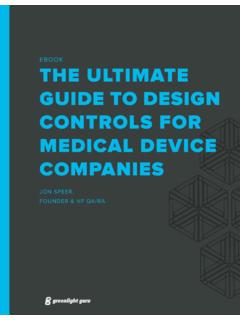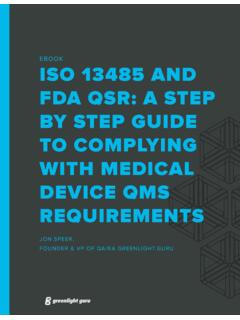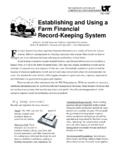Transcription of EBOOK THE RISK MANAGEMENT + DESIGN CONTROLS …
1 THE RISK MANAGEMENT + DESIGN CONTROLS connection : what DEVICE MAKERS NEED TO KNOWEBOOKJON SPEER, FOUNDER & VP OF QA/RA OF CONTENTSTHE RISK MANAGEMENT + DESIGN CONTROLS connection : what DEVICE MAKERS NEED TO KNOW2. Intended Use & User Needs9. Verification, Validation, & Risk Controls17. Using DESIGN Reviews EffectivelyMedical devices are intended to save and improve quality of like the ISO 13485:2003 definition of a medical device: Any instrument, apparatus, implement, machine, appliance, implant, in vitro reagent or calibrator, software, material or other similar or related article, intended by the manufacturer to be used, alone or in combination, for human beings for one or more of the specific purpose(s) of: diagnosis, prevention, monitoring, treatment or alleviation of disease diagnosis, monitoring, treatment, alleviation of or compensation for an injury investigation, replacement, modification, or support of the anatomy or of a physiological process supporting or sustaining life control of conception disinfection of medical devices providing information for medical purposes by means of in vitro examination of specimens derived from the human body A medical device should address a specific patient and clinical need, defined by manufacturers in an intended use statement.
2 Intended use is key to your product development and risk MANAGEMENT efforts, as well as critical to your regulatory strategy, helping to determine classification and go-to-market USE & USER NEEDSPAGE 2 THE RISK MANAGEMENT + DESIGN CONTROLS connection : what DEVICE MAKERS NEED TO is really where a medical device s journey begins. DESIGN CONTROLS and risk MANAGEMENT should flow and blend together, and it s important to establish this flow early in product development. Intended use is a gateway to user needs, DESIGN & development plan, DESIGN inputs, risk MANAGEMENT plan, hazards, hazardous situations, and foreseeable sequence of UseUser NeedsDesign &DevelopmentPlanRiskManagementPlanHazard sDesign InputsHazardousSituationsForeseeableSequ ence of EventsINTENDED USE HELPS DEFINE USER NEEDSI ntended use defines the purpose of a medical device. User needs are then derived and defined from the intended use to describe: Who will use this device?
3 PAGE 3 THE RISK MANAGEMENT + DESIGN CONTROLS connection : what DEVICE MAKERS NEED TO KNOW How will the user and patient interact with the device? what type of procedures will the device be used for? what type of environment will the device be used in? When will the device be used? Is the device used one time, or over and over? what other products will the device interact and interface with?I ve talked before about the importance of user needs in the DESIGN CONTROLS process. User needs start the waterfall, and DESIGN validation closes the process, cycling back to user 4 THE RISK MANAGEMENT + DESIGN CONTROLS connection : what DEVICE MAKERS NEED TO INTENDED USE TO YOUR DESIGN & DEVELOPMENT PLANI ntended use and user needs define the scope of a project, and they are instrumental in establishing a DESIGN & development plan. Such a plan needs to define: DESIGN & development stages and activities Who is responsible for DESIGN & development activities Resources required, such as project team members and key vendors Timing of DESIGN reviewsThe plan is not a one and done and needs to be revisited and updated throughout the INPUTS BUILD ON USER NEEDSTo define DESIGN inputs for your medical device, you need to understand user needs.
4 I m guessing you can cite several projects where you were able to define DESIGN inputs, but there may not have been any defined user needs. Actually, there were user needs they just might not have been documented, and this can be an needs should always be defined and documented. Doing so helps to define DESIGN inputs. Otherwise, you might have to guess and fill in the blanks. When this latter approach is taken, you can progress far into product development before realizing your device has not addressed key aspects from the end-user PAGE 5 THE RISK MANAGEMENT + DESIGN CONTROLS connection : what DEVICE MAKERS NEED TO KNOWand patient perspective. It s even possible to launch a device into the market and discover later, through product complaints, that you overlooked some user use usually comprises a few sentences that describe what a product is supposed to do. User needs are a series of statements that further describe the intended use.
5 It is okay if your user needs are somewhat vague and example, a user need may state something like the product should be easy to use. This is where DESIGN inputs come into play. They describe and define easy to use in clear, objective terms. Think of the DESIGN inputs as a contract a product developer should be able to reference this contract during DESIGN and development of the USE GUIDES RISK MANAGEMENT PLANNINGOne of the first steps involved in medical device risk MANAGEMENT is establishing a risk MANAGEMENT plan, which describes risk MANAGEMENT activities throughout the product lifecycle. Roles and responsibilities, as well as the risk MANAGEMENT team, are defined. Intended use is important because it helps to establish the scope to which risk MANAGEMENT activities will be risk MANAGEMENT plan also includes criteria for your medical device s risk acceptability, which should be commensurate with the intended use.
6 Like the DESIGN & development plan, a risk MANAGEMENT plan is continually evolving throughout the product 6 THE RISK MANAGEMENT + DESIGN CONTROLS connection : what DEVICE MAKERS NEED TO , HAZARDOUS SITUATIONS, FORESEEABLE SEQUENCE OF EVENTS BASED ON INTENDED USERisk MANAGEMENT also includes risk analysis and risk evaluation described in Understanding ISO 14971 Medical Device Risk MANAGEMENT . Risk analysis and risk evaluation make up what is known as a risk intended useUnderstand and define the scope of yourdevice and document its intended use2 Identify hazards3 Identify the potential sources of harm associated with your are known as hazardsEstimate risk of each hazardous situationDefine hazardous situations and foreseeable sequences of events4 Risk is the combination of severity ofpotential harm and probability of thatharm occuringEstimate risk5%RISK ANALYSIS (2-5)RISK ASSESSMENT (2-6)Snap shot of risk analysis and risk evaluation from ISO 14971 risk assessment, based on a device s intended use, determines the possible hazards, hazardous situations, and foreseeable sequence of events related PAGE 7 THE RISK MANAGEMENT + DESIGN CONTROLS connection : what DEVICE MAKERS NEED TO KNOWto your medical device.
7 A hazard is a potential source of harm, while a hazardous situation is a circumstance in which people, property, or the environment are exposed to one or more hazard(s). The foreseeable sequence of events lays out the steps required for a hazardous situation to connection BETWEEN DESIGN CONTROLS AND RISK MANAGEMENTJust as intended use plays a vital role in DESIGN control and risk MANAGEMENT , DESIGN control and risk MANAGEMENT are vital to one another. Some companies treat DESIGN CONTROLS and risk MANAGEMENT as related but separate processes, not realizing the close connection between user needs, DESIGN inputs, hazards, and hazardous use leads to user needs, which lead to DESIGN inputs the contract by which medical devices are designed and developed. Intended use also helps define the scope of a DESIGN & development plan, as well as the scope of a risk MANAGEMENT plan. All of this information is used to determine hazards, hazardous situations, and foreseeable sequence of I stated at the beginning of this article, medical devices are intended to save and improve quality of life.
8 Following sound DESIGN CONTROLS and risk MANAGEMENT processes helps ensure that the devices you DESIGN , develop, manufacture, and sell are as safe and effective as 8 THE RISK MANAGEMENT + DESIGN CONTROLS connection : what DEVICE MAKERS NEED TO , VALIDATION, & RISK CONTROLSThe previous article in this series addressed DESIGN control and risk MANAGEMENT connections through intended use and user needs specifically, how these items are key to identifying hazards, hazardous situations, and foreseeable sequence of recap, intended use leads to user needs, which lead to DESIGN inputs. Think of DESIGN inputs as a contract by which medical devices are designed and developed. Intended use also helps define the scope of a DESIGN & development plan, as well as the scope of a risk MANAGEMENT me also remind you of the high-level risk MANAGEMENT process overview defined in ISO 14971:Requires RBAR equires RBAR equires RBAR equires RBAR equires RBAR equires RBAR equires RBAR equires RBAR equires RBAR equires RBAR equires RBAR equires RBAR equires RBAR equires RBAN egligibleNo or negligible riskto patientMinorSlight customer inconvenience;little to no e ect on productperformance, non-vital faultSeriousShort-term injury or impairmentrequiring additional medical intervention to correct ( reoperation)MajorSevere, long-term injury;potential disabilityCriticalLoss of limb.
9 Life-threatening injuryFrequent1 in 100 Probable1 in 1,000 Occasional1 in 10,000 Remote1 in 100,000 Improbable1 in 1,000,000 Risk Acceptability MatrixProbabilitySeverity8 Evaluate risk of the product in its entirety. Is the risk level acceptable?Do the benefits outweigh the potential risks ?Evaluate the risks identifiedEvaluation Of Overall Risk Acceptability6 Are these risk levels acceptable? Is risk reduction required?Use Risk CONTROLS to reducerisks to acceptable levels:Risk Control7 Carry out a risk MANAGEMENT reviewand prepare a risk MANAGEMENT reportbefore sending your device to commercial MANAGEMENT Report9 RISK ANALYSIS (6)RISK control (7)RISK ACCEPTABILITY (8)REVIEW AND REPORT (9)PRODUCTION INFORMATION (10)Production And Post-production Information10 Internal audits, CAPAs, complaints, customer feedback and non-conforming material all feed into the risk MANAGEMENT MANAGEMENT is a total product lifecycle FeedbackComplaintsCAPAsInternal auditsTotalProductLifecycleRisk MANAGEMENT ProcessRisk MANAGEMENT ProcessPAGE 9 THE RISK MANAGEMENT + DESIGN CONTROLS connection .
10 what DEVICE MAKERS NEED TO KNOWR equires RBAR equires RBAR equires RBAR equires RBAR equires RBAR equires RBAR equires RBAR equires RBAR equires RBAR equires RBAR equires RBAR equires RBAR equires RBAR equires RBAN egligibleNo or negligible riskto patientMinorSlight customer inconvenience;little to no e ect on productperformance, non-vital faultSeriousShort-term injury or impairmentrequiring additional medical intervention to correct ( reoperation)MajorSevere, long-term injury;potential disabilityCriticalLoss of limb; life-threatening injuryFrequent1 in 100 Probable1 in 1,000 Occasional1 in 10,000 Remote1 in 100,000 Improbable1 in 1,000,000 Risk Acceptability MatrixProbabilitySeverity8 Evaluate risk of the product in its entirety. Is the risk level acceptable?Do the benefits outweigh the potential risks ?Evaluate the risks identifiedEvaluation Of Overall Risk Acceptability6 Are these risk levels acceptable?











